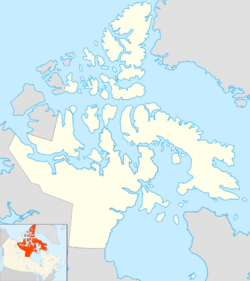Simialuk facts for kids
| Geography | |
|---|---|
| Location | Northern Canada |
| Coordinates | 69°46′12″N 82°38′38″W / 69.77000°N 82.64389°W |
| Archipelago | Arctic Archipelago |
| Administration | |
|
Canada
|
|
| Territory | Nunavut |
| Region | Qikiqtaaluk |
| Demographics | |
| Population | Uninhabited |
Simialuk (in Inuktitut syllabics: ᓯᒥᐊᓗᒃ) is an island in the far north of Canada. It used to be called Ormonde Island. This island has an unusual, uneven shape. It sits right at the eastern entrance of a narrow waterway called the Fury and Hecla Strait.
Simialuk is part of Nunavut, which is a large territory in Canada's Arctic. It belongs to the Qikiqtaaluk Region. The island is located north of the Melville Peninsula and south of Baffin Island. It is also west of a large body of water known as Foxe Basin. Simialuk is about 91 m (299 ft) (about 300 feet) above sea level.
Contents
Where is Simialuk Island Located?
Simialuk Island is found in the very cold and remote Arctic Archipelago. This is a huge group of islands in the Arctic Ocean. The island's exact spot is at the eastern opening of the Fury and Hecla Strait. This strait is a passage that connects different parts of the Arctic waters.
How Does Simialuk Fit in the Arctic?
The island is positioned in a key area of the Canadian Arctic. To its north is Baffin Island, one of the largest islands in the world. Between Simialuk and Baffin Island lies a smaller island called Elder Island. To the south, Simialuk is separated from the Melville Peninsula by the Labrador Narrows. This narrow channel is another important waterway in the region.
What is Simialuk Island Like?
Simialuk is an uninhabited island, meaning no people live there permanently. It is part of the vast, icy landscape of the Canadian Arctic. The island's elevation of 91 meters above sea level suggests it has some higher points, but it is not a mountainous island.
Why is it Uninhabited?
Many islands in the Canadian Arctic are uninhabited. This is because of the extremely cold climate, long winters, and limited resources. The Arctic environment is very challenging for human settlement. However, these islands are important for wildlife and scientific research.
The Name Simialuk
The island's current name, Simialuk, comes from the Inuktitut language. Inuktitut is spoken by the Inuit people, who are the Indigenous people of the Arctic. The name change from Ormonde Island to Simialuk reflects the importance of Indigenous languages and heritage in Canada.



